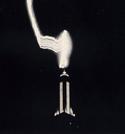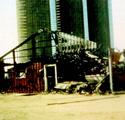OWT - Lightning never strikes the same place twice.

Wrong
It has been documented that the empire state building has been struck up to 30+ times in a single year.
Wrong
Even a single lightning discharge consists of an initial strike with one or several more “return strokes” in the same discharge event. Thus a building, tree, person, or other object is likely actually struck several times in one lightning event.
OWT - Lightning always strikes the tallest object.

Wrong
Lightning strikes don’t actually “make up their minds” where they will strike until the strike leader is within approximately 150’ of ground or a grounded object. In most cases, this will probably be the tallest object in an area - but - as witnessed by this photo – not always.
FAQ - Does a lightning strike always start a fire?

Not always. Lightning strikes can have one of several effects subject to the nature of the strike (its current and voltage values) and subject to the type of structure that is hit.
- Fire: a lightning strike to a high resistance, combustible substance, i.e. a wood framed house can easily start a fire if the current flow is high enough and the duration long enough.
- Explosive effect: If the strike is of high current but short duration, the effect can be explosive in nature; shattering wood framing or masonry walls and stacks as shown in these photos.
- Electrical: Lightning currents can enter a building’s wiring and communications system causing melting, fire and/or destruction of solid state/computerized or low voltage systems. A device designed to operate 5, 12, 14 volts etc doesn’t stand a chance against a lightning strike with up to one million volts.
FAQ - How much does a lightning protection system cost?

The cost will vary dependent upon:
- Materials used. Copper or aluminum components and cabling are allowed per lightning protection codes. Aluminum will be less expensive.
- Concealed versus exposed installation. Lightning protection systems can be installed on an existing building’s exterior (A skilled installer can do this in a very inconspicuous way), or mostly built into the structure in a concealed manner for a new construction project. This will likely be slightly more costly due to some additional labor.
- Size and design of the house. A large home with several dormers and chimneys will obviously cost more to protect than a basic single ridge ranch design. In general terms, however, the cost of the system seldom exceeds 1% of the home’s value.
FAQ - What will installing a system do for my insurance?
In most cases, there is no rate credit or premium reduction but State Farm and other insurers strongly support lightning protection systems. See brochure in our “Library”. However, lightning protection can be seen as a cheap, long term insurance by itself. Who needs the hassle of rebuilding and refurnishing a structure damaged or destroyed by lightning. Besides, given the trend to higher and higher deductibles, a proper lightning protection system will prevent the need for that eventuality.
OWT - Metal covered buildings are safe from lightning.

Wrong
Lightning strikes can penetrate metal up to 3/16” thick. Metal roofing and siding are not permitted by code to act as part of a lightning protection system. Grounding or bonding metal siding is not lightning protection by any means.
OWT - Any person struck by lightning will be killed.
Right and Wrong
The statement is unfortunately true in many cases but not in all instances. Lightning may temporarily shock the heart and respiration into stopping but in many cases prompt use of CPR or other appropriate available first aid can restart these functions and bring a victim “back to life”. Don’t hesitate to try and resuscitate a non-responsive lightning strike victim.
FAQ - Is it safe to use the phone during a thunderstorm?
Yes, if it’s a cell phone or cordless handset.
No, if it’s a hard wired land line and handset.
FAQ - Is it safe to take a shower or bath during a lightning storm?
Yes, if all plumbing, drains, and bath surfaces are non-metallic/non-conductive i.e. plastic supply and drain lines in tile or fiberglass tubs/showers.
No, especially in older buildings with metal water and drain lines and cast iron tubs.
OWT - Modern buildings and houses don’t need lightning protection.

Wrong
Modern construction and materials in reality make buildings more vulnerable.
- Structures are more often located in open, exposed suburban areas
- Traditional lightning targets like large trees and overhead power lines are not as prevalent or may not be present at all in new development areas with underground services.

- Plastic plumbing and mechanical lines have eliminated prior alternative paths to ground for lightning strikes to buildings
- Electrical equipment within the building is much more sensitive due to the widespread use of solid state computer chips in many systems such as security, garage openers, TVs, microwaves, computers and phones where in the past much tougher mechanical switches and relays were used.
OWT - Nothing can be done to prevent lightning damage to structures.
Wrong. Wrong. Wrong!
A properly designed and installed lightning protection system combined with adequate lightning surge arresters is virtually 100% effective in protecting a building, its contents, and most importantly, its occupants from lightning related damage or injury. There are three national standards groups that publish standards covering components and proper installation practices and methods.
OWT - They don’t use “lightning rods” anymore.

Wrong
The lightning protection industry is alive, growing and more
effective than ever before. Many years ago, at an industry meeting,
one of the “old timers” summed up the probable basis for the above
misconception. His explanation was that the industry was no longer
using the tall elevated and often ornamental rods” that were
 traditional for previous generations on barns, farmhouses and other
rural structures. By the time he stated this, the industry had been
able, based on scientific research and updated general knowledge
about lightning, to reduce the size of the rods to a 10” minimum
height with many portions of the systems now able to be concealed
within the building itself. This major shift in visual impact is
probably the basis for this misconception. The number of buildings
with protection systems installed has been increasing for several
years.
traditional for previous generations on barns, farmhouses and other
rural structures. By the time he stated this, the industry had been
able, based on scientific research and updated general knowledge
about lightning, to reduce the size of the rods to a 10” minimum
height with many portions of the systems now able to be concealed
within the building itself. This major shift in visual impact is
probably the basis for this misconception. The number of buildings
with protection systems installed has been increasing for several
years.
FAQ - If the lightning protection system cables are concealed, won’t they get hot and start a fire when the system gets struck?
No! The lightning conductors are very large. The system affords
multiple paths to ground so the total current is safely divided and
the current flow duration of a lightning strike is only micro seconds
long, so heat does not have time to build up in a properly grounded
system.

OWT - Far off storms are not a threat.

Wrong
Beware the bolt from the blue. Lightning strikes can hit the earth up to 10 or more miles away from an approaching storm.


